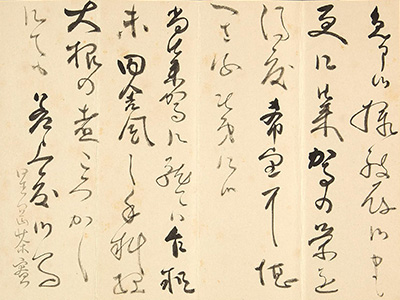Chapter 9 Artists
OKAKURA Tenshin, 1862-1913
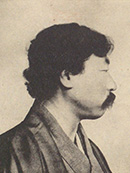 Okakura was an art teacher during the Meiji era. He studied English and Chinese since he was a child, and studied under Ernest Francisco Fenollosa at the University of Tokyo. He worked for establishing the Tokyo School of Fine Arts (later the Tokyo University of the Arts), and became its president. In 1898, he established the Nihon Bijutsuin (the Japan Art Institute) with his students including Yokoyama Taikan and Hishida Shunso. He became a head of the Eastern division of the Museum of Fine Arts, Boston, and he devoted himself to introduce Japanese art abroad.
Okakura was an art teacher during the Meiji era. He studied English and Chinese since he was a child, and studied under Ernest Francisco Fenollosa at the University of Tokyo. He worked for establishing the Tokyo School of Fine Arts (later the Tokyo University of the Arts), and became its president. In 1898, he established the Nihon Bijutsuin (the Japan Art Institute) with his students including Yokoyama Taikan and Hishida Shunso. He became a head of the Eastern division of the Museum of Fine Arts, Boston, and he devoted himself to introduce Japanese art abroad.
97 Okakura Tenshin shokan, August 27, 1896[Sakatani Yoshiro Papers: 224]
This is a letter written by Tenshin replying to Sakatani Yoshiro’s letter. Tenshin was a president of the Tokyo University of the Arts, and Sakatani was a Ministry of Finance official. It is assumed that Sakatani asked Okakura to whom he should order the painting of the carp that is realistically drawn. In the letter, Okakura says Hashimoto Gaho’s paintings are great, but for realistic paintings, he recommends Kawabata Gyokusho’s. He also mentions the names of prominent young artists such as Shimomura Kanzan. Later, Sakatani became a Minister of Finance, mayor of Tokyo City and a member of the House of Peers.
YOKOYAMA Taikan, 1868-1958
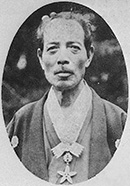 Yokoyama was a Japanese-style painter. He studied under Hashimoto Gaho and Okakura Tenshin. After graduating from the Tokyo School of Fine Arts, he joined the Nihon Bijutsuin (the Japan Art Institute). In 1914, he revived the Nihon Bijutsuin whose activities had been interrupted due to the pressures of the Conservative Faction. He played the most important role as a modern Japanese-style master painter. His vaguely outlined style is called “Morotai”.
Yokoyama was a Japanese-style painter. He studied under Hashimoto Gaho and Okakura Tenshin. After graduating from the Tokyo School of Fine Arts, he joined the Nihon Bijutsuin (the Japan Art Institute). In 1914, he revived the Nihon Bijutsuin whose activities had been interrupted due to the pressures of the Conservative Faction. He played the most important role as a modern Japanese-style master painter. His vaguely outlined style is called “Morotai”.
98 Yokoyama Taikan shokan, October 7, [ca. 1922][Makino Nobuaki Papers, Letters: 658]
This is a letter from Taikan to Makino Nobuaki who was an Imperial Household Minister. The letter says that Taikan will present Tenshin zenshu (by Okakura Tenshin[507-28]![]() ) according to the message from Kawai Gyokudo. The letter seems to be sent with the book. After resigning from the presidentcy of the Tokyo School of Fine Arts, Tenshin established the Nihon Bijutsuin (the Japan Art Institute). Taikan and Gyokudo participated from its establishment. The letter shows their communications.
) according to the message from Kawai Gyokudo. The letter seems to be sent with the book. After resigning from the presidentcy of the Tokyo School of Fine Arts, Tenshin established the Nihon Bijutsuin (the Japan Art Institute). Taikan and Gyokudo participated from its establishment. The letter shows their communications.
TAKEUCHI Seiho, 1864-1942
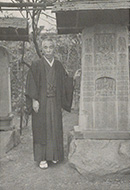 A Japanese-style painter. He was born in Kyoto and graduated from Kyotofu Gagakko (later Kyoto City University of Arts). It was often said “Taikan in the East, and Seiho in the West”, which indicates how he worked actively as the center of Kyoto Gadan (the Kyoto painting circles) and taught many disciples, taking major part in modernizing Japanese painting. He received the first Order of Culture along with Yokoyama Taikan and Koda Rohan.
A Japanese-style painter. He was born in Kyoto and graduated from Kyotofu Gagakko (later Kyoto City University of Arts). It was often said “Taikan in the East, and Seiho in the West”, which indicates how he worked actively as the center of Kyoto Gadan (the Kyoto painting circles) and taught many disciples, taking major part in modernizing Japanese painting. He received the first Order of Culture along with Yokoyama Taikan and Koda Rohan.
99 Takeuchi Seiho shokan, July 22, 1925[Sekiya Teizaburo Papers: 693-8]
This is a card to express appreciation for entertainment written by Seiho to Sekiya Teizaburo who was a Vice Minister of the Imperial Household. On the card, Seiho drew an illustration which depicts an incident at Higashi Izu after he left Tokyo. When he was smoking beneath a cliff, a boy was fishing and happened to catch an octopus, which surprised both Seiho and the boy― and even the octopus. The incident was humorously illustrated with the octopus on the fish rod with lively feeling which shows Seiho’s ability in drawing animals.
KITAOJI Rosanjin, 1883-1959
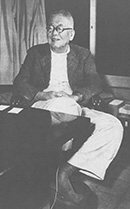 Kitaoji was an artist. He first established himself as a calligrapher and with tenkoku (seal-engraving). He then studied antiques and cooking. After he established Hoshigaoka saryo, a high-class restaurant for members only, he began to be seriously involved in pottery. He was active in many art fields.
Kitaoji was an artist. He first established himself as a calligrapher and with tenkoku (seal-engraving). He then studied antiques and cooking. After he established Hoshigaoka saryo, a high-class restaurant for members only, he began to be seriously involved in pottery. He was active in many art fields.
100 Kitaoji Rosanjin shokan, June 6, early Showa era[Makino Nobuaki Papers, Letters: 204]
This is a letter written by Rosanjin to Makino Nobuaki. While running Hoshigaoka saryo, the high-class restaurant in Nagata-cho in the beginning of the Showa era, Rosanjin built Seikoyo in Kitakamakura and created ceramics. The letter is an invitation to Makino for Seikoyo where Rosanjin wanted to host him with country dishes. “Hoshigaoka saryo” printed at the left bottom of the letter indicates it was an original paper.






